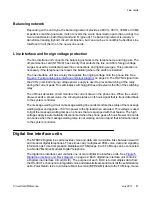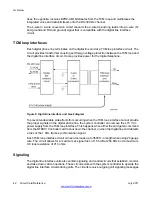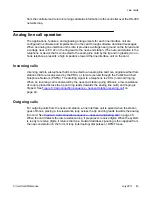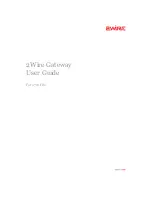
from the controller and return incoming call status information to the controller over the DS-30X
network loop.
Analog line call operation
The applications, features, and signalling arrangements for each line interface unit are
configured in software and implemented on the card through software download messages.
When an analog line interface unit is idle, it provides a voltage near ground on the tip lead and
a voltage near –48 V dc on the ring lead to the near-end station. (The near-end station is the
telephone or device that is connected to the analog line card by the tip and ring leads.) An on-
hook telephone presents a high impedance toward the line interface unit on the card.
Incoming calls
Incoming calls to a telephone that is connected to an analog line card can originate either from
stations that are local (served by the PBX), or remote (served through the Public Switched
Telephone Network (PSTN)). The alerting signal to a telephone is 20 Hz (nominal) ringing.
When an incoming call is answered by the near-end station going off-hook, a low-resistance
dc loop is placed across the tip and ring leads (towards the analog line card) and ringing is
tripped. See
Figure 6: Call connection sequence - near-end station receiving call
on
page 44.
Outgoing calls
For outgoing calls from the near-end station, a line interface unit is seized when the station
goes off-hook, placing a low-resistance loop across the tip and ring leads towards the analog
line card. See
Figure 7: Call connection sequence - near-end originating call
When the card detects the low-resistance loop, it prepares to receive digits. When the system
is ready to receive digits, it returns dial tone. Outward address signaling is then applied from
the near-end station in the form of loop (interrupting) dial pulses or DTMF tones.
Line cards
Circuit Card Reference
July 2011 43
Summary of Contents for 1000 Series
Page 1: ...Circuit Card Reference Nortel Communication Server 1000 7 0 NN43001 311 04 04 July 2011 ...
Page 20: ...20 Circuit Card Reference July 2011 ...
Page 30: ...Introduction 30 Circuit Card Reference July 2011 Comments infodev avaya com ...
Page 116: ...Option settings 116 Circuit Card Reference July 2011 Comments infodev avaya com ...
Page 143: ...Figure 25 CP PIV card front Physical description Circuit Card Reference July 2011 143 ...
Page 148: ...NT4N39AA CP Pentium IV Card 148 Circuit Card Reference July 2011 Comments infodev avaya com ...
Page 287: ...Figure 86 Clock Controller Option 3 Operation Circuit Card Reference July 2011 287 ...
Page 302: ...NT5K21 XMFC MFE card 302 Circuit Card Reference July 2011 Comments infodev avaya com ...
Page 346: ...NT6D80 MSDL card 346 Circuit Card Reference July 2011 Comments infodev avaya com ...
Page 353: ...Figure 96 NTDK16 DLC Functional description Circuit Card Reference July 2011 353 ...
Page 461: ...Figure 147 Paging trunk operation Applications Circuit Card Reference July 2011 461 ...
Page 462: ...NT8D15 E and M Trunk card 462 Circuit Card Reference July 2011 Comments infodev avaya com ...
Page 500: ...NTAK09 1 5 Mb DTI PRI card 500 Circuit Card Reference July 2011 Comments infodev avaya com ...
Page 512: ...NTAK10 2 0 Mb DTI card 512 Circuit Card Reference July 2011 Comments infodev avaya com ...
Page 534: ...NTAK79 2 0 Mb PRI card 534 Circuit Card Reference July 2011 Comments infodev avaya com ...
Page 550: ...NTBK22 MISP card 550 Circuit Card Reference July 2011 Comments infodev avaya com ...
Page 560: ...NTBK50 2 0 Mb PRI card 560 Circuit Card Reference July 2011 Comments infodev avaya com ...
Page 595: ...Figure 165 MGC block diagram Introduction Circuit Card Reference July 2011 595 ...
Page 662: ...NTRB21 DTI PRI DCH TMDI card 662 Circuit Card Reference July 2011 Comments infodev avaya com ...
Page 668: ...NTVQ01xx Media Card 668 Circuit Card Reference July 2011 Comments infodev avaya com ...
Page 700: ......
















































